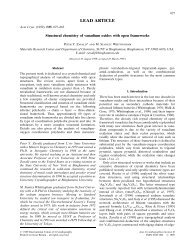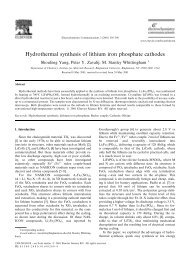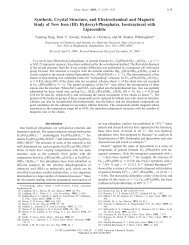Manganese Vanadium Oxide Compounds as Cathodes for Lithium ...
Manganese Vanadium Oxide Compounds as Cathodes for Lithium ...
Manganese Vanadium Oxide Compounds as Cathodes for Lithium ...
You also want an ePaper? Increase the reach of your titles
YUMPU automatically turns print PDFs into web optimized ePapers that Google loves.
Mat. Res. Soc. Symp. Proc. Vol. 658 © 2001 Materials Research Society<br />
<strong>Manganese</strong> <strong>Vanadium</strong> <strong>Oxide</strong> <strong>Compounds</strong> As <strong>Cathodes</strong> For <strong>Lithium</strong> Batteries<br />
J. Katana Ngala, Peter Y. Zavalij and M. Stanley Whittingham*<br />
Institute <strong>for</strong> Materials Research and Department of Chemistry<br />
State University of New York at Binghamton,<br />
Binghamton, NY13902-6000, USA.<br />
ABSTRACT<br />
A pure <strong>for</strong>m of the compound [(CH 3 ) 4 N] 0.2 Mn 0.06 V 2 O 5+δ •0.2H 2 O h<strong>as</strong> been synthesized by<br />
the hydrothermal technique. A manganese richer compound, [(CH 3 ) 4 N] 0.18 Mn 0.1 V 2 O 5+δ •0.35H 2 O,<br />
h<strong>as</strong> also been synthesized. By comparison to [(CH 3 ) 4 N] 0.17 Fe 0.1 V 2 O 5+δ •0.17H 2 O, the structure of<br />
these compounds consists of double sheets of vanadium oxide with tetramethyl ammonium ions<br />
in the interlayer spaces. Both compounds display reversible lithium intercalation with sharp end<br />
points. The lithiation capacity is lowered by the incre<strong>as</strong>e in manganese content.<br />
INTRODUCTION<br />
Transition metal oxides may act <strong>as</strong> cathodes in lithium secondary batteries partly due to the<br />
ability of the metal ions to exhibit variable oxidation states, and their highly negative free<br />
energies of reaction with lithium ions, in contr<strong>as</strong>t to other chalcogenides.<br />
The commercially available layered LiCoO 2 h<strong>as</strong> good cyclability. However, it finds limited<br />
use such <strong>as</strong> in lap tops and cellular phones, due to its high cost. The spinel compound, LiMn 2 O 4 ,<br />
which w<strong>as</strong> found to act <strong>as</strong> an intercalation host in the early 1980s, h<strong>as</strong> been developed <strong>for</strong><br />
commercial use <strong>as</strong> a replacement <strong>for</strong> LiCoO 2 in second-generation Li-ion batteries; the<br />
manganese is lower cost than cobalt. Un<strong>for</strong>tunately, only 0.5 Li per Mn may be inserted and deinserted<br />
reversibly [1]. This corresponds to a capacity of about 110 Ah/kg in contr<strong>as</strong>t to 130<br />
Ah/kg <strong>for</strong> LiCoO 2 .<br />
<strong>Vanadium</strong> oxides have been extensively investigated <strong>as</strong> possible cathodes <strong>for</strong> lithium<br />
batteries. A cl<strong>as</strong>s of compounds of particular interest <strong>for</strong> potential use in batteries is that<br />
consisting of the δ-V 2 O 5 structure. This structure type contains double vanadium oxide sheets<br />
with the vanadyl groups on the outside of the sheets; the vanadium is in a distorted octahedral<br />
coordination rather than the square pyramid typical of V 2 O 5 itself and the well known bronzes,<br />
such <strong>as</strong> LiV 2 O 5 . One of the most studied vanadium oxide cathodes,V 6 O 13 , contains these sheets<br />
and cycles lithium well [2] in secondary cells. Typical simple members of this cl<strong>as</strong>s are<br />
Ni 0.25 V 2 O 5 [3], [N(CH 3 ) 4 ] 0.3 Fe 0.1 V 2 O 5 and Zn 0.4 V 2 O 5 [4].<br />
We report here on the preparation of a pure ph<strong>as</strong>e of [N(CH 3 ) 4 ] y Mn z V 2 O 5+δ •nH 2 O<br />
(compound A) by hydrothermal synthesis. Earlier we reported [5] this ph<strong>as</strong>e <strong>as</strong> one component<br />
of a two ph<strong>as</strong>e mixture. We also report on an isostructural material (compound B) with a higher<br />
manganese content. We compare their electrochemical behavior. Hydrothermal synthesis and<br />
other soft chemistry techniques such <strong>as</strong> sol-gel synthesis, have been widely applied <strong>for</strong> the low<br />
temperature syntheses of metal oxides. These techniques are useful in accessing met<strong>as</strong>table metal<br />
oxides.<br />
GG9.16.1
EXPERIMENTAL<br />
Compound A w<strong>as</strong> hydrothermally synthesized by the treatment of V 2 O 5 (Alfa-Aesar) with<br />
an aqueous solution of HMnO 4 , in the presence of the templating cation [(CH 3 N) 4 ]OH (Alfa-<br />
Aesar). The reacting mole ratio w<strong>as</strong> V 2 O 5 :HMnO 4 :[(CH 3 ) 4 N]OH = 1:0.15:2. Nitric acid w<strong>as</strong><br />
added to lower the pH. HMnO 4 w<strong>as</strong> obtained by ion exchanging the pot<strong>as</strong>sium in KMnO 4<br />
(Fisher) using an acidic cation exchange resin. The mixture w<strong>as</strong> transferred to an autoclave after<br />
thorough stirring, placed in an oven at 165 0 C and left to react <strong>for</strong> 3 days. The pH of the reaction<br />
mixture w<strong>as</strong> initially 2.4 and 3.5 at the end of the reaction. This pH range along with the given<br />
reacting mole ratios ensured pure product. The brown clay-like solid w<strong>as</strong> filtered and rinsed with<br />
distilled water.<br />
Compound B w<strong>as</strong> prepared by taking the above product (compound A) and adding to it<br />
LiOH and HMnO 4 , in the mole ratio 3:1:1, respectively. The same heat treatment <strong>as</strong> above w<strong>as</strong><br />
followed. The reaction proceeded under similar pH conditions (2.2-3.5). A dark brown clay w<strong>as</strong><br />
isolated.<br />
X-ray powder diffraction w<strong>as</strong> per<strong>for</strong>med using Cu Kα radiation on a Scintag θ-θ<br />
diffractometer equipped with a Ge (Li) solid state detector. The data w<strong>as</strong> collected from 2θ = 2 0<br />
to 2θ = 90 0 with 0.02 0 steps and 10 sec. per step count time. The TGA data w<strong>as</strong> obtained on a<br />
Perkin Elmer model TGA 7, the FTIR on a Bruker Equinox and electron microscopy on a JEOL<br />
8900. A mixture of the sample, carbon black and polyvinylidene fluoride <strong>as</strong> the binder, w<strong>as</strong><br />
prepared in the weight ratio 8:1:1, respectively. Cyclopentanone w<strong>as</strong> added to the mixture and<br />
thoroughly mixed to obtain a slurry that w<strong>as</strong> coated on a 1 cm 2 aluminium disk using a dropper.<br />
After air–drying the disk w<strong>as</strong> placed in an oven at about 150 0 C <strong>for</strong> effective dehydration <strong>for</strong> at<br />
le<strong>as</strong>t 5 hours. Swagelok test cells were used with lithium metal, adhered to a nickel disk, <strong>as</strong> the<br />
anode. The electrolyte w<strong>as</strong> 1M LiPF 6 dissolved in a 2:1 mixture of ethylene carbonate (EC) and<br />
dimethyl carbonate (DMC).<br />
RESULTS AND DISCUSSION<br />
Compound A:<br />
EDS analysis on compound A indicated the presence of V and Mn in the ratio Mn:V =<br />
0.06:2. This corresponds to z = 0.06 in the <strong>for</strong>mula, [N(CH 3 ) 4 ] y Mn z V 2 O 5+δ·nH 2 O (standard<br />
deviation = ±0.01). The amount of Mn obtained here is less than previously reported, probably<br />
due to extra manganese present in the other ph<strong>as</strong>es of the earlier product.<br />
Powder x-ray analysis, shown in Figure 1, indicates a single ph<strong>as</strong>e product in contr<strong>as</strong>t to<br />
that reported earlier [5] which had mixed ph<strong>as</strong>es. The pattern, which suggests low crystallinity,<br />
w<strong>as</strong> indexed using a monoclinic unit cell in the space group C2/m, with the following<br />
parameters: a = 11.66 Å, b = 3.61 Å, c = 13.91 Å and = 108.8 0 . The low crystallinity is<br />
confirmed by the SEM image, which shows a fuzzy layered morphology.<br />
The powder x-ray pattern gives a repeat distance of 13.1 Å, consistent with δ-V 2 O 5 sheets<br />
having TMA ions sandwiched in the interlayer spacing. The in-plane spacing of 3.6 Å points to<br />
disordered organic cations <strong>as</strong> the diameter of these cations is >5Å. Un<strong>for</strong>tunately, Rietveld<br />
GG9.16.2
efinement could not be per<strong>for</strong>med <strong>as</strong> the quality of the XRD pattern w<strong>as</strong> insufficient. The<br />
structure w<strong>as</strong> deduced from the similarity of its XRD pattern with that of<br />
[(CH 3 ) 4 N] 0.17 Fe 0.1 V 2 O 5+δ·0.17H 2 O whose structure we reported earlier [4]. From this analogy, we<br />
postulate that the structure of compound A consists of VO 6 distorted octahedra <strong>for</strong>ming double<br />
sheets of V 2 O 5 <strong>as</strong> shown in Figure 2.<br />
300<br />
Relative Intensity<br />
250<br />
200<br />
150<br />
100<br />
50<br />
0 0 1<br />
0 0 2<br />
2 0 -1<br />
0 0 3<br />
1 1 0<br />
0 0 4<br />
1 1 2<br />
4 0 1<br />
0 0 6<br />
6 0 -3<br />
5 1 1<br />
6 0 3<br />
0 0 10<br />
0<br />
10 20 30 40 50 60 70 80 90<br />
2θ<br />
Figure 1: Powder x-ray pattern <strong>for</strong> [N(CH 3 ) 4 ] y Mn z V 2 O 5+ •nH 2 O;z = 0.06.<br />
Figure 2: The structure <strong>for</strong> [N(CH 3 ) 4 ] y Mn z V 2 O 5+ •nH 2 O.<br />
The FTIR spectrum (Figure 3) indicates the presence of a V=O group by the peak at 1012<br />
cm -1 . The vanadyl groups are projected away from the double layers. The band at 3421 cm -1 is<br />
due to the presence of water, where<strong>as</strong> those at 517 cm -1 and 754 cm -1 are attributed to V-O<br />
vibrations in the framework. The presence of the tetramethylammonium ion is indicated by the<br />
three bands situated at 2900 cm -1 , 1481 cm -1 and 950 cm -1 .<br />
GG9.16.3
0.5<br />
Transmittance<br />
0.45<br />
0.4<br />
0.35<br />
0.3<br />
0.25<br />
4000 3500 3000 2500 2000 1500 1000 500<br />
Wavenumber, cm -1<br />
Figure 3: FTIR spectrum <strong>for</strong> [N(CH 3 ) 4 ] y Mn z V 2 O 5+ •nH 2 O; z = 0.06.<br />
Thermal analysis, per<strong>for</strong>med under oxygen atmosphere, results in two weight losses <strong>as</strong><br />
displayed in Figure 4. The 1.8% weight loss in the range, 100 0 C-250 0 C is <strong>as</strong>sociated with water<br />
of solvation between the sheets. This corresponds to n = 0.20 in the <strong>for</strong>mula:<br />
[(CH 3 ) 4 N] y Mn z V 2 O 5+δ •nH 2 O. The weight loss be<strong>for</strong>e 100 0 C is <strong>as</strong>sociated with surface water. The<br />
7.6% weight loss over the range 250 0 C-300 0 C is due to decomposition of the organic,<br />
corresponding to y = 0.21 in the <strong>for</strong>mula: [(CH 3 ) 4 N] y Mn z V 2 O 5+δ •nH 2 O.<br />
100<br />
95<br />
Under O<br />
2<br />
Weight %<br />
90<br />
85<br />
80<br />
100 200 300 400 500 600<br />
Temperature, °C<br />
Figure 4: TGA profile <strong>for</strong> [N(CH 3 ) 4 ] y Mn z V 2 O 5+ • •nH 2 O; z = 0.06.<br />
The product obtained by subjecting the sample to a constant temperature of 200 0 C <strong>for</strong> 4<br />
hours shows an XRD pattern that is identical to that of the original sample. This implies that<br />
water is not crucial <strong>for</strong> the integrity of the structure. However, upon heating to 600 0 C, the<br />
structure collapses <strong>as</strong> evidenced by the XRD pattern of the resulting product. The pattern is<br />
consistent with a mixture of MnV 2 O 6 and V 2 O 5 .<br />
The electrochemical data shows an open circuit potential of 3.62 V, consistent with<br />
vanadium in the +5 oxidation state. Figure 5 displays the charge–discharge profile of 7 cycles. It<br />
indicates initial capacity of 220 Ah/kg, corresponding to about 2 Li per <strong>for</strong>mula unit. The same<br />
capacity w<strong>as</strong> reported <strong>for</strong> the earlier product [5]. We still observe the plateau at about 2.8 V,<br />
suggesting some ph<strong>as</strong>e change during cycling.<br />
GG9.16.4
5<br />
4<br />
Volts<br />
3<br />
2<br />
1<br />
Initial discharge<br />
0<br />
-50 0 50 100 150 200 250<br />
Capacity, Ah/kg<br />
Figure 5: Cycling of [N(CH 3 ) 4 ] y Mn z V 2 O 5+ ; z = 0.06 at 0.1 ma/cm 2 .<br />
Compound B<br />
EDS analysis yields the approximate ratio Mn:V = 0.1:2, corresponding to z = 0.1(1) in the<br />
<strong>for</strong>mula [(CH 3 ) 4 N] y Mn z V 2 O 5+δ .nH 2 O. On the other hand, the powder XRD pattern of this product<br />
is identical to that of compound A, so that that the additional Mn content does not alter the δ-<br />
ph<strong>as</strong>e structure.<br />
Figure 6 gives the thermal analysis profile <strong>for</strong> this compound. The 3.0% weight loss over<br />
the temperature 82 0 C-200 0 C corresponds to n = 0.35 in the <strong>for</strong>mula [(CH 3 ) 4 N] y Mn z V 2 O 5+δ .nH 2 O,<br />
where<strong>as</strong> the 6.3% loss in the interval, 200 0 C-350 0 C corresponds to y = 0.18. Thus, concomitant<br />
with incre<strong>as</strong>e in Mn content in the structure is a decre<strong>as</strong>e in the amount of the organic cation and<br />
an incre<strong>as</strong>e in water of solvation. This suggests that probably the manganese ions, <strong>as</strong> the organic<br />
cations, are situated in the interlayer spaces in hydrated <strong>for</strong>m. Thus the introduction of more<br />
manganese ions causes the displacement of the organic cations.<br />
100<br />
Under O<br />
2<br />
Weight percent<br />
95<br />
90<br />
85<br />
80<br />
100 200 300 400 500 600<br />
Temperature, °C<br />
Figure 6: Thermogravimetric profile <strong>for</strong> [N(CH 3 ) 4 ] y Mn z V 2 O 5+ .•nH 2 O; z = 0.1.<br />
GG9.16.5
The electrochemical behavior of this compound I shown in Figure 7. It exhibits an open<br />
circuit potential of 3.59 V, which is slightly less than that <strong>for</strong> compound A, due to the higher<br />
manganese content which will probably reduce the overall oxidation state of the oxide matrix.<br />
The cell w<strong>as</strong> charged initially; essentially no capacity w<strong>as</strong> observed during this charging process<br />
indicating no lithium in the sample, even though the reaction medium contained much lithium.<br />
5<br />
4<br />
Volts<br />
3<br />
2<br />
1<br />
Initial charge<br />
0<br />
-50 0 50 100 150 200 250<br />
Capacity, Ah/kg<br />
Figure 7: Cycling of [N(CH 3 ) 4 ] y Mn z V 2 O 5+ ; z = 0.1 at 0.1ma/cm 2 .<br />
Figure 7 shows that the capacity of the cell, 180 Ah/kg, is significantly reduced from the<br />
220 Ah/kg of sample A. The re<strong>as</strong>on <strong>for</strong> this is not fully understood, <strong>as</strong> the 0.04 additional Mn<br />
ions cannot account <strong>for</strong> the drop of around 0.4 Li per <strong>for</strong>mula unit simply b<strong>as</strong>ed on oxidation<br />
state changes or site occupancy. It is possible that this loss is in part a kinetic effect, with the<br />
additional manganese ions pinning the layers together much <strong>as</strong> just a few per cent additional<br />
titanium ions in Li x Ti 1+y S 2 can cut the lithium diffusion coefficient by several orders of<br />
magnitude [6].<br />
CONCLUSIONS<br />
The pure <strong>for</strong>m of the δ-ph<strong>as</strong>e compound [(CH 3 ) 4 N] 0.2 Mn 0.06 V 2 O 5+δ •0.2H 2 O w<strong>as</strong><br />
hydrothermally synthesized. A more manganese rich ph<strong>as</strong>e, [(CH 3 ) 4 N] 0.18 Mn 0.1 V 2 O 5+δ •0.35H 2 O<br />
w<strong>as</strong> synthesized from the <strong>for</strong>mer compound. Both compounds display reversible cycling <strong>as</strong><br />
cathodes, although the latter h<strong>as</strong> lower capacity than the <strong>for</strong>mer.<br />
We are currently investigating other δ-ph<strong>as</strong>e compounds of the series, to which the two<br />
compounds belong, with the aim of evaluating their per<strong>for</strong>mance <strong>as</strong> cathodes <strong>for</strong> lithium ion<br />
batteries. Work is also in progress to explore other types of pillars <strong>for</strong> the layers and to study the<br />
manganese oxide analogs.<br />
GG9.16.6
ACKNOWLEDGEMENTS<br />
We thank the Department of Energy, Office of Transportation Technologies, through<br />
Lawrence Berkeley Laboratory, and the National Science Foundation through Grant<br />
DMR–9810198 <strong>for</strong> partial support of this work. We also thank Bill Blackburn <strong>for</strong> the SEM<br />
studies.<br />
REFERENCES<br />
1. A. R. Armstrong, A. D. Robertson, R. Gitzendanner, and P. G. Bruce, J. Solid State Chem.,<br />
145, 549-550(1999).<br />
2. Ö. Bergström, H. Björk, T. Gustafsson, J. O. Thom<strong>as</strong>, J. Power Sources, 81-82(1999) 685.<br />
3. Y. Oka, T. Yao, N. Yamamoto, J. Solid State Chem., 132 (1997) 323.<br />
4. F. Zhang, P. Y. Zavalij and M. S. Whittingham, Mater. Res. Bull., 32 (1997) 701.<br />
5. F. Zhang and M. S. Whittingham, Electrochem. Comm., 2 (2000) 69.<br />
6. M. S. Whittingham, Progress in Solid State Chemistry, 12 (1978) 41.<br />
GG9.16.7








